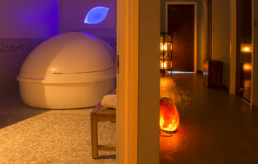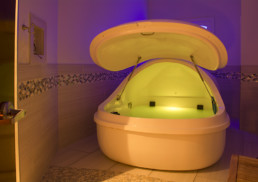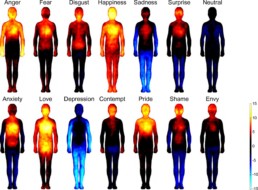Try a float tank to explore an interior landscape with a saltwater fix, even if you’re city-bound, landlocked, and only have an hour.
Do you miss the saltwater?
Even for those who live at the coast, our daily lives and the time pressures we all accept as part of responsible adult life so often keep us from the places that rejuvenate and inspire us. Somewhere along the way, we assented to a push of priorities that prevent us from getting the daily (or even weekly) dose of mystery and beauty that can render the routine sacred and turn boring repetition into disciplined discovery. When just a few minutes’ time creek or seaside could make all the difference there are weeks when we feel like we can’t (or won’t) find that time.
In his interview with the inimitable Krista Tippett the late, great philosopher and poet John O’Donohue said
I’d say seven out of every ten people who turn up in a doctor’s surgery are suffering from something stress-related. Now there are big psychological tomes written on stress, but for me, philosophically, stress is a perverted relationship to time, so that rather than being a subject of your own time, you have become its target and victim, and time has become routine. So at the end of the day, you probably haven’t had a true moment for yourself to relax in and to just be.
Waves to Wisdom exists to guide people into a more creative, fulfilling, and abundant relationship with their time. The littoral zone is the sandy frontier where the land and we terrestrial creatures cede control to waves and water, the planet’s dominant element. The place is filled with both dynamic facts and transformative metaphors. When you’re there, standing on that edge or, even better, floating just beyond it, everywhere you look there are wordless poems writing themselves in their own meter and cadence. Water reflects and refracts light and, in the process, mixes colors, composes passages, spits out short, fleeting lyrics that, if you’re fully present and attentive, can swell your heart. And, if the visual and aural reveries weren’t enough, there’s the feel of the place– the ephemeral motion that, if you let your body succumb to its rhythm and internalize it, can change your mind, your day, and your life.

The littoral zone is the sandy frontier where the land and we terrestrial creatures cede control to waves and water, the planet’s dominant element. The place is filled with both dynamic facts and transformative metaphors.
But what if you don’t live near the ocean? All water is liquid and chaotic and rhythmic according to forces that, by their very complexity, are mysterious to our perceiving minds. Even dry landscape has its own movement and, although the timbre is subtler, it still offers portals into what O’Donohue calls a “true moment.” But what if you only have an hour in your busy week? Don’t work or live anywhere near a natural landscape?
You might want to spend an hour in a floatation tank. I just experienced my first float, after hearing Dr. Justin Feinstein, neuropsychologist and director of the Laureate Institute for Brain Research (LIBR), present at the annual Blue Mind Summit. The summit is a gathering of people from diverse professions and backgrounds who gather to share information and camaraderie about their work in support of the theory that being in, on, near, or under water is good for human health, mental and physical.
Feinstein summarized his paradigm-shifting research into the mental health benefits of Floatation Restricted Environmental Stimulation Therapy (REST), or spending time in a dark, shallow bath of warm water with so much Epsom salt in it you couldn’t sink if you tried. He is accumulating mounting evidence that Floatation REST works better than any known drug to combat anxiety and depression. He’s also convinced it can provide crucial help to people fighting anorexia and addiction.

And it seems floating doesn’t just aid in just mental recovery. This straightforward, non-toxic practice with almost no unpleasant side-effects appears to aid recovery and relaxation after any sort of stress, including hard work-outs of your mind, body, or both. Powerful testimonials abound from people who beat eating disorders, Olympic athletes who recovered faster, even musicians who credited floating with enhancing their skills. I’d heard about float tanks for years but Feinstein’s talk left me resolved, once and for all, to get into one.

A week later I entered a TruRest floatation center through a nondescript door in a strip mall near my house. They call themselves a spa. The attendant ushered me down a hallway with dim lights and clean, neatly rolled towels on spare shelves.
I arrived at one of several private rooms, each with a shower and a smooth, white tank, lit within by rotating colored lights. The attendant walked me through the process, showed me the intercom button in case I needed help and offered a few options (tank door open or closed?, music on or off?, head resting on water or a little foam floaty?). Then she left me alone.
Squeaky clean, and earplugs inserted, I lowered into the 10-inch deep water with its 1000 pounds of dissolved Epsom salt. Some people suffer from claustrophobia so it’s not required to close the tank door but I wanted the full, womblike experience so I pulled the hatch closed, flipped the light switch and settled into the total, device-free sort of darkness we rarely experience. At my request, the soft music would stop after a few minutes and only begin again when my hour of floating was nearing its end. I tried a meditation technique I and many of my clients respond to right away, the full body scan. Just focusing on each part of your body in turn, feeling it in space, noticing it without judgment, then moving onto the next. In this warm water and the moist air, all calibrated to human temperature, it was difficult to tell where I ended and the world began. Instead of feeling lost, space and body somehow became one and, although my leg still felt like my leg, it and every other every part of me began to feel as though it encompassed a deep interior, larger, lighter, and more expansive than usual. My exploring mind had more room to maneuver inside my feet, then legs, then sacrum. With so much spaciousness and no external distractions, I soon felt a sensation I often have to work long and hard to achieve on the landward side of the littoral zone— a freedom from any desire to be anywhere else “better”, or to perceive something else more beautiful. It felt like my body and mind, even random thoughts that popped up here and there, they were all just me, not separated. Every thought and feeling was inextricably one, varied terrain in this small, dark sea– not good, not bad, just spacious.
It’s precisely this sort of moment of intimate connection between the body and the brain, and technologies to help bring this connection to the forefront of awareness, that is Feinstein’s and LIBR’s guiding principle. In that dark, buoyant place, experiencing as complete a sensory return to archetypal, maternal beginnings as I can imagine encountering with my adult body, the intimacy was undeniable.
I hadn’t felt like I was worried going into the tank but somewhere in the middle of the float, thoroughly relaxed in the darkness after less than an hour of this remarkable experience, as those random thoughts materialized and dissolved, I realized how much tension and busyness I’d been carrying in my mind and body. I had to work to recall the source of all that vague but profoundly felt concern. Less than one hour. Total relaxation. No pill could work any faster.
In fact, Feinstein’s most recent work focused on the effects of a single hour of Floatation-REST on people with severe depression and anxiety. Those effects were amazing! With almost no negative side effects (a few folks experienced mild itchiness or dry mouth) the article reported participants experienced significant reductions in anxiety, stress, muscle tension, pain, depression, and poor mood. As a matter of fact, “there was … a substantial improvement in mood characterized by increases in serenity, relaxation, happiness, positive affect, overall well-being, energy levels, and feeling refreshed, content and peaceful.”
These positive effects were more pronounced for the group with anxiety and depression than the healthy control group. In other words, the more they needed it, the more it helped.
These positive effects were more pronounced for the group with anxiety and depression than the healthy control group. In other words, the more they needed it, the more it helped.
Previous research showed that the positive takeaways of REST included lowering blood pressure and levels of the stress hormone cortisol. People also experienced increases in well-being, and performance. As if that weren’t enough encouragement to try floating, a 2014 study looked at the effects of floatation REST on a group of professionals participating in a company-sponsored wellness initiative. The results? “Stress, depression, anxiety, and worst pain were significantly decreased whereas optimism and sleep quality significantly increased.”
But how does it work? After all, I’m as Western in my outlook as anyone and I want to know the mechanism. What’s going on in that salty pool? In short, we don’t know yet. Feinstein’s questions focus on the neuroscience of fear, anxiety, and other negative emotions and mood disorders. He believes our bodies play a powerful role in all of our emotional states.
Scientists have learned that our brains are constantly receiving information about how various regions or systems in our bodies are doing, and then engaged in an unconscious cartography of mapping this information. Research in the last decade has shown that people from different cultures tend to locate the physical sensation of particular emotions in the same areas of the body. In other words, our body maps seem to be consistent across cultures and appear to be much more nature than nurture. Feinstein posits that disturbances in those maps might underlie many common mental disorders. If we can tune into our body maps by floating, apparently weightless, in silent darkness, we might be able to heal ourselves.
We have a culture that encourages a habitual tendency to ignore or denigrate the role of our bodies when we aren’t working out, or having sex, or some other explicitly physical activity. And when we do inhabit our bodies we so often do so with critical, editorial judgment rather than curiosity, gratitude, and a sense of exploration. This habit diminishes the quality of our lives, our work, and our contributions to our communities.
And when we do inhabit our bodies we so often do so with critical, editorial judgment rather than curiosity, gratitude, and a sense of exploration. This habit diminishes the quality of our lives, our work, and our contributions to our communities. If we can develop regular practices that allow us to increase our non-judgmental bodily awareness and, in turn, our awareness of the other bodies around us (including the more than human ones) we’ll all be more effective, creative leaders in our work and lives. With practice coming home to the reality that your body and mind are not actually separate, you can live a life more grounded in joy, play, and freedom and feel more like an honest, authentic version of yourself. And those better versions of us can do a much better job of managing ourselves, enhancing the quality of what we offer our various communities and, potentially, the habitats that support all of the above.
After all, one of the premises of Waves to Wisdom is that our bodies are a crucial but undervalued source of creativity, learning, and positive change. We have a culture that encourages a habitual tendency to ignore or denigrate the role of our bodies when we aren’t working out, or having sex, or some other explicitly physical activity.
But the mind-body split is as old as our culture and not easy to overcome. Inside the tank, I felt I’d somehow managed to do just that. Almost instantly, there was a disorienting, enveloping peace that allowed me to just notice random thoughts without chasing them or reacting emotionally. As the hour passed, I experimented with different arm positions and found the most comfortable one: elbows bent, hands above my head, as if surrendering. Life in the tank felt boundless, as if I were in a vast space akin to the beach or a mountainside, without any of the confinement I often feel in my car or even my living room. I was completely relaxed. Utterly supported with none of gravity’s reminders of mid-life joints. I could feel every part of my heartbeat’s rhythm. I lost any inkling of how much time was passing. Once I was surprised by what sounded like someone striking a small bell, a single, loud tone. Then I realized the sound was from a slight movement of my upper lip away from my front tooth. There was a kind of quiet in there I can’t remember ever experiencing and I could hear and feel things that are normally hidden in the din. This is precisely what Feinstein thinks is behind the dramatic results of his recent study of Floatation-REST therapy on people with severe anxiety and depression.
With practice coming home to the reality that your body and mind are not actually separate, you can live a life more grounded in joy, play, and freedom and feel more like an honest, authentic version of yourself. And those better versions of us can do a much better job of managing ourselves, enhancing the quality of what we offer our various communities and, potentially, the habitats that support all of the above.
When the music came on, I couldn’t believe an hour had passed. I climbed out of the tank and felt as though I’d just awoken from the best, longest sleep. After a long, hot shower to wash off the salt and linger in the feeling it left me with, I stopped at the front desk and signed up for regular monthly floats. The TruRest Spa I visited is one of many centers that offer a discount for regular attendance.
So many of us suffer from an inability to stop our habitual frenetic thoughts and motions, to slow down, deeply attend to what’s within, and learn from that attention. It’s no surprise that this is the case. All of our conveniences train us to stay shallow, go fast, and get to what’s next. As difficult as they are to come by in most of our days, periods of deep interiority have the capacity to allow us to sense our most engaged, freest selves. Somewhere in that lost familiarity with calm freedom of just being lie clues to what we might have to offer with different practices, ones that encouraged more depth in our noticing and fuller presence in our receiving. We can emerge from these moments with an understanding of our innate creativity, and how we might use it where we work and live. How we might serve more effectively, more wholly, and in ways that because they are true to who we are deep down in our bodies, energize rather than deplete us.
We can emerge from these moments with an understanding of our innate creativity, and how we might use it where we work and live. How we might serve more effectively, more wholly, and in ways that because they are true to who we are deep down in our bodies, energize rather than deplete us.
In the same interview I quoted above, O’Donohue said
“What amazes me about landscape — landscape recalls you into a mindful mode of stillness, solitude, and silence, where you can truly receive time.”
What I found in the tank was something resonant with the receptivity of an amazed mind as it dances in call and response with vast landscapes. It seems as though sometimes, if you really want to bring about more profound movement and change, to make a beautiful splash in the world, some buoyed stillness is the best place to begin. Even if you only have an hour.
To find a floatation center in your area or learn more about floatation therapy, visit this link: https://floatationlocations.com/
Sources:
“Examining the short-term anxiolytic and antidepressant effect of Floatation-REST” Justin S. Feinstein, Sahib S. Khalsa, Hung-wen Yeh, Colleen Wohlrab, W. Kyle Simmons, Murray B. Stein, Martin P. Paulus. Published: February 2, 2018
“Bodily maps of emotions” Lauri Nummenmaa, Enrico Glerean, Riitta Hari, and Jari K. Hietanen. PNAS January 14, 2014 111 (2) p 646-651.
“Eliciting the relaxation response with the help of flotation-rest (restricted environmental stimulation technique) in patients with stress-related ailments.” Bood, S. Å., Sundequist, U., Kjellgren, A., Norlander, T., Nordström, L., Nordenström, K., & Nordström, G. (2006). International Journal of Stress Management, 13(2), p 154-175.
“Floatation restricted environmental stimulation therapy (REST) as a stress-management tool: A meta-analysis” Dirk van Dierendonck, Jan Te Nijenhuis. p 405-412
“John O’Donohue: The Inner Landscape of Being” On Being with Krista Tippett
“The Acute Effects of Flotation Restricted Environmental Stimulation Technique on Recovery From Maximal Eccentric Exercise” Morgan, Paul M.; Salacinski, Amanda J.; Stults-Kolehmainen, Matthew A. Journal of Strength and Conditioning Research: December 2013 – Volume 27 – Issue 12 – p 3467–3474


